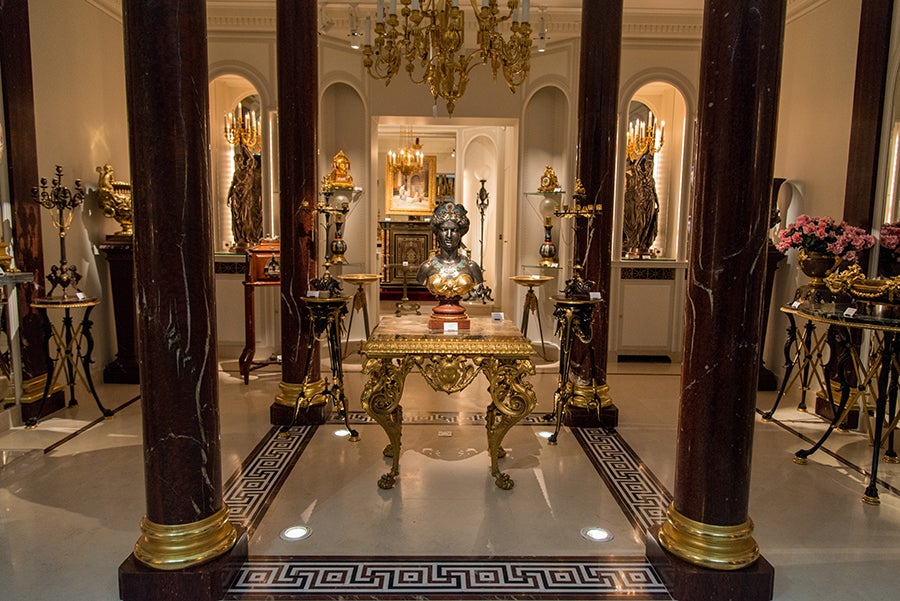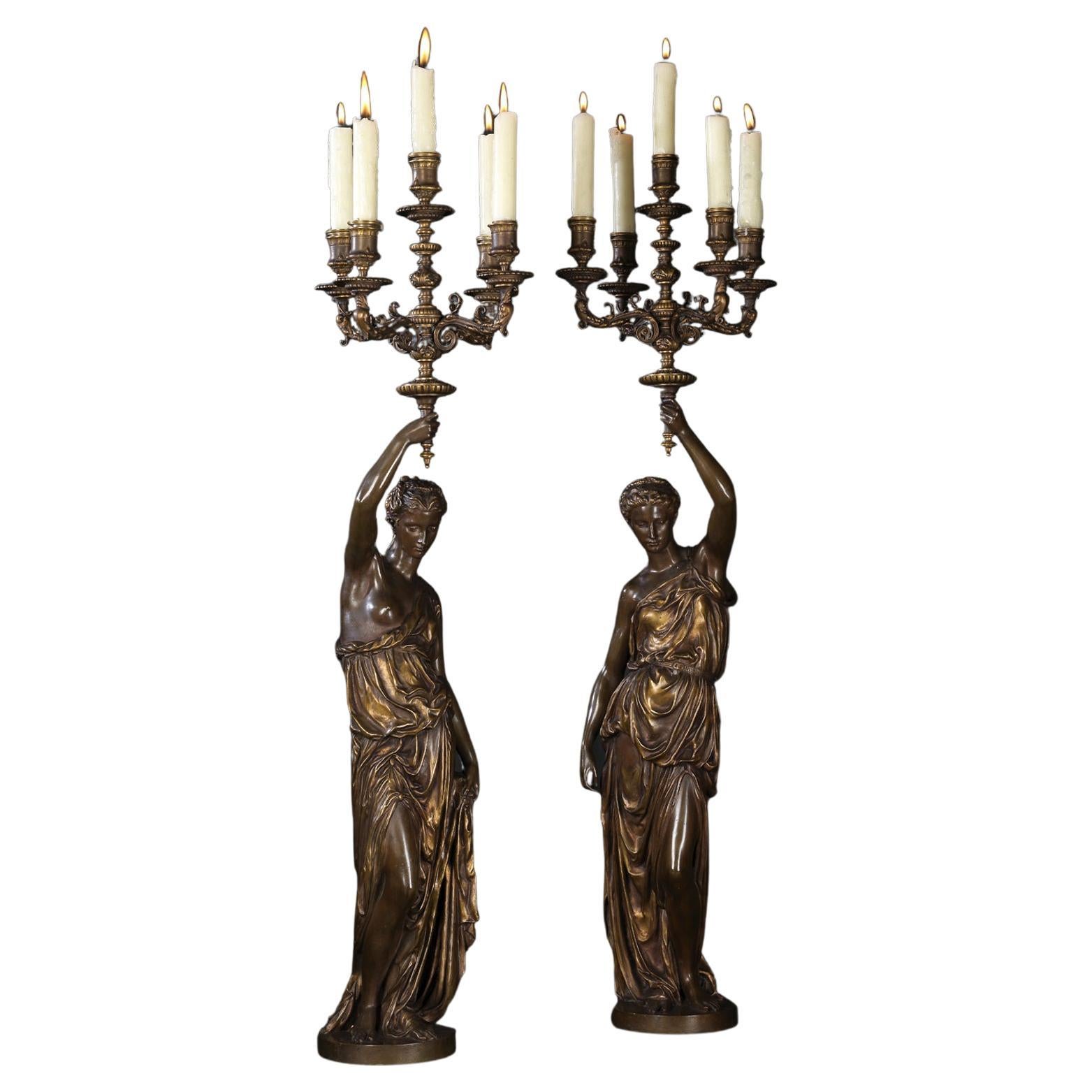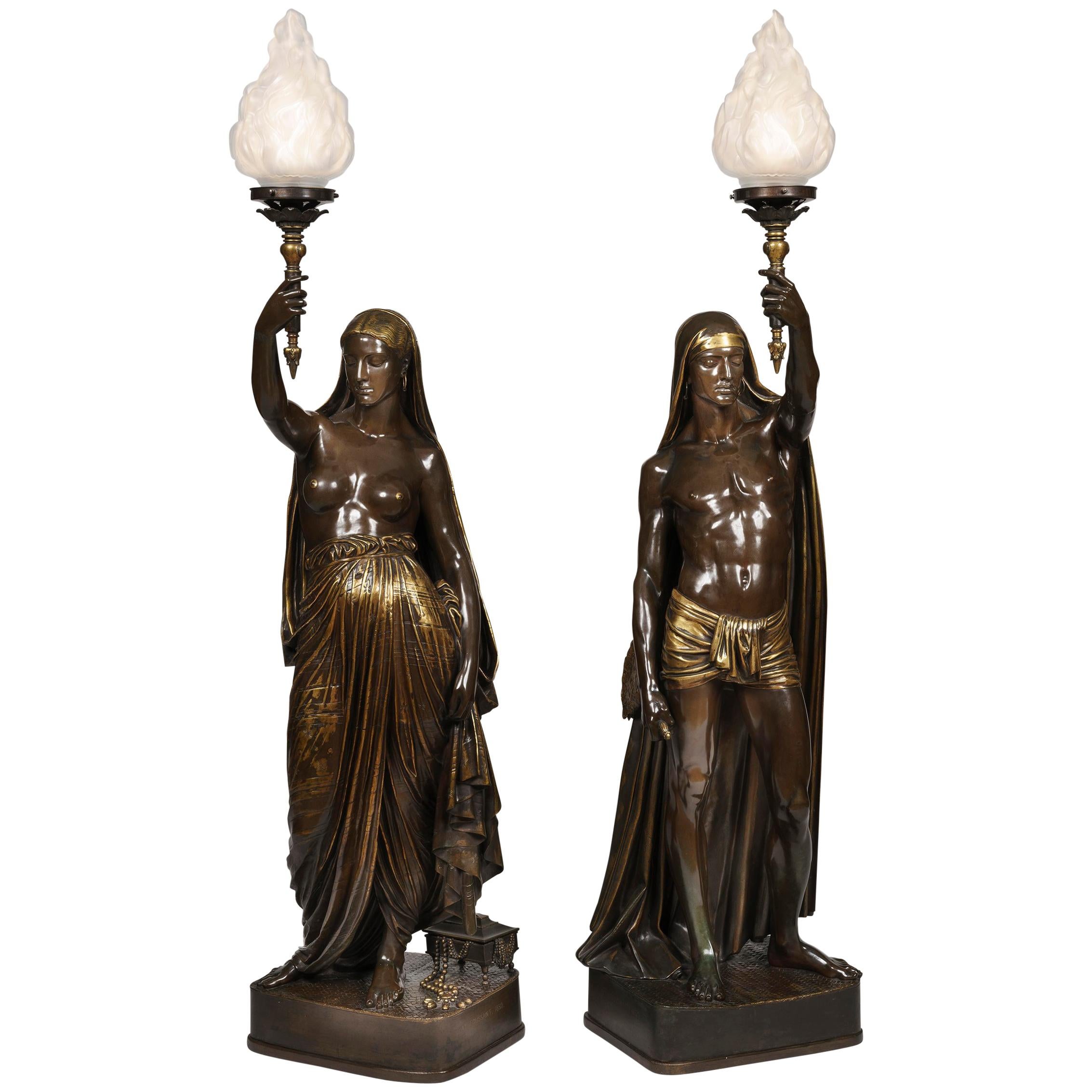Elegant Pair of Bronze Torcheres by F. Barbedienne, P. Dubois and A. Falguière
About the Item
- Creator:
- Dimensions:Height: 50.01 in (127 cm)Width: 16.93 in (43 cm)Depth: 23.63 in (60 cm)
- Sold As:Set of 2
- Materials and Techniques:
- Place of Origin:
- Period:
- Date of Manufacture:circa 1867
- Condition:Wear consistent with age and use.
- Seller Location:PARIS, FR
- Reference Number:1stDibs: LU3860320618772
Ferdinand Barbedienne
Founded by one-time Parisian wallpaper dealer Ferdinand Barbedienne and engineer Achille Collas, one of the most revered foundries in 19th-century France began with the invention of a revolutionary 1830s-era device that could produce proportional reproductions — large or small — of sculptures. Collas’s machine, which yielded miniature likenesses of antiquities for the interiors of homes the world over, was pivotal to the success of the F. Barbedienne Foundry. The successful firm earned prestigious awards and critical acclaim and created exquisite bronze candleholders, clocks and lamps for a range of wealthy and prominent clients.
The duo first launched their company under the name Société Collas et Barbedienne, and early on, they optimized chemical processes for pigmenting and patinating their bronze statuettes. After Collas died in 1859, Barbedienne forged on alone, and the company’s name changed to simply F. Barbedienne.
Barbedienne employed more than 300 workers at that point, and the Maison created a range of furnishings and decorative objects that featured the integration of marble and ormolu accents. However, with the onset of the Franco-Prussian War of 1870, the foundry was forced to retrofit its molds, and the production of cannons replaced sculptures, furniture and vases.
When Ferdinand Barbedienne passed away in 1891, his nephew and heir, Gustave Leblanc, took over as president, changing the name to Leblanc-Barbedienne. Leblanc expanded production into Germany, the United Kingdom and the United States, carrying on the company's legacy with monumental sculptures, and models and securing production rights for famous statues. Paul-Alexandre Dumas, an Art Nouveau maker and student of Louis Majorelle, succeeded Leblanc until the company's closing in 1952.
Barbedienne pieces had been exhibited regularly in the 19th century and were especially prevalent at Europe’s international expositions and world’s fairs, where they received numerous prizes. Today, the Musée d’Orsay in Paris holds dozens of Barbedienne works in its collection, including intricate mirrors, vases and cups created by Louis-Constant Sévin at the foundry. For more than two decades, Sévin created lamps, boxes and more at Maison Barbedienne. Working alongside award-winning chaser Désiré Attarge, Sévin designed Napoleon III-era works that greatly appealed to European nobility.
Other notable artists who collaborated with Barbedienne included Eugene Aizelin, Emmanuel Fremiet, Antonin Mercié, Emile Guillemin, Edouard Lievre, Ferdinand Levillain and Auguste Rodin.
On 1stDibs, find a collection of antique Ferdinand Barbedienne decorative objects, lighting and more.

- ShippingRetrieving quote...Ships From: Saint Ouen, France
- Return PolicyA return for this item may be initiated within 7 days of delivery.
- Magnificent Console by Barbedienne, Falguière and Dubois, France, Circa 1880By F. Barbedienne Foundry, Paul Dubois, Jean Alexandre Joseph Falguière 1Located in PARIS, FRTotal height with mirror: 383 cm (151 in.) Console : Height : 97 cm (38 in.) ; Length : 291 cm (114 in.) ; Depth : 47 cm (18 in.) Height with pedestals : 178 cm (70 in.) – Width of pedestals tops : 36 x 23 cm (14 x 9 in.) Provenance: Hôtel de Bourbon-Condé, for the Conte de Chambrun, 12 rue Monsieur, 7th arrondissement, Paris. This magnificent white carrare and bleu turquin marble Louis XVI style console is embellished with carved and gilded bronze ornaments. The belt, adorned with a fluted frieze, masks of Bacchus and rosettes, is standing on six spirally fluted feet with foliage on the extremities. The part meant to be placed against the wall is divided in several pannels framed with moulded and beaded bronze. Above the console stands a giltwood and white-painted mirror, richly decorated at its top with a carved head of Apollo flanked by acanthus leaves and treillis. The mirror is framed by two patinated bronze female figures, each holding seven-light candelabra and standing on pedestals richly adorned with laurel garlands and bronze frames. These are casts by F.Barbedienne, after models by J.A.J. Falguière and P.Dubois (they are signed to the base, one ‘FALGVIERE and F.BARBEDIENNE. FONDEUR’, the other ‘P.DUBOIS’ and ‘F.BARBEDIENNE’). The original models of these bronzes were shown at the 1867 Exposition Universelle before being installed at the Château de Compiègne for the enjoyment of Napoleon III and Empress Eugénie. The masterful console was commissionned to Barbedienne around 1880 to garnish the interiors of the Conte de Chambrun at the Hôtel de Bourbon-Condé, 12 rue Monsieur, 7th arrondissement, Paris. This console was part of the sale of the count’s art and furniture collections that took place on the 18th of June 1900 after the count’s death (listed as lot n°52 in the sale catalogue). Born in 1810, died in Paris in 1892, Ferdinand Barbedienne, the most important caster of bronze pieces of art during the second half of the 19th Century, created and directed in Paris one of the major artistic founderies of his time. Barbedienne specialised in classical reproductions, whose models were exposed in famous European museums. Their illustrated catalogues included many diverse objects such as busts, ornemental sculpture (clocks, candelabras, cups) sometimes even life-sized and also bronzes for furniture. Apart from his own production, Barbedienne worked for the most renowned sculptors such as Barrias, Clésinger and Carrier-Belleuse. All his works were highly esteemed and he, himself honoured by contemporary critics. At the London exhibition in 1851 Barbedienne's firm won two « Council medals ». At the 1855 Universal Exhibition, he won a medal of honour. The success of Barbedienne's firm brought him many official commissions. At the London Universal Exhibition of 1862 Barbedienne won medals in three different categories : Furniture, Silversmith work and Artistic bronzes. Barbedienne was made an officer of the Légion d'Honneur in 1867 and Commander in 1878 when he was compared with « a prince of industry and the king of bronze casting ». His glory did not decline with the passage of the time for at the Universal Exhibition of 1889 the critics thanked Barbedienne for the example he set for other bronze-casters by the perfection of his bronzes. Paul Dubois (1829-1905) studied law before entering the workshop of Toussaint, then the School of Fine Arts. After travelling in Italy, he participated to the Salon of 1863 and won the third medal for the sculpture category. He won several other medals : the Medal of Honour with his Florentine Singer...Category
Antique 1880s French Louis XVI Pier Mirrors and Console Mirrors
MaterialsMarble, Bronze
- "Florentine Singer" Bronze Sculpture by P. Dubois and F. Barbedienne, Circa 1880By Paul Dubois, Ferdinand BarbedienneLocated in PARIS, FRSigned P. Dubois 1865 and F. Barbedienne fondeur Stamped with réduction mécanique Collas A patinated bronze « Florentine Singer » sculpture, inspir...Category
Antique 1880s French Figurative Sculptures
MaterialsBronze
- Pair of "Indian Slave" Torcheres by Toussaint & Barbedienne, France, circa 1850By Achille Collas, Ferdinand Barbedienne, François-Christophe-Armand ToussaintLocated in PARIS, FRSigned Ad Toussaint 1850 and F. Barbedienne Fondeur Stamped Achille Collas Réduction Mécanique Torcheres – height : 148 cm (58 1/4 in.) ; width : 34 cm (13 1/3 in.) Pedestals – ...Category
Antique 1850s French Napoleon III More Lighting
MaterialsCrystal, Bronze
- Pair of Bronze Torchères by E.Colin after a Model by A.Carrier, France, c. 1900By Albert-Ernest Carrier-Belleuse, Colin, ParisLocated in PARIS, FRInscribed A. Carrier and Anc. Mon Colin éditeur – fondeur, Paris Measures: Torchère height 193 cm (75.9 in.), base height 29 cm (11.4 in.), diameter base 40 cm (15.7 in.). 2 torchères + 2 bases Exceptional pair of "Night" and "Day" female torchère-holders, made in dark patinated bronze. Each dressed with antique style drapes, and holding up a gilt-bronze five light-arms candelabra. Day, bareheaded and with braided hair ; Night, the head covered by her coat and holding poppy flowers and fruits symbolizing sleep. Standing on a molded pedestal. These female torchère-holders repeat a common theme created by Carrier-Belleuse, what model for one of the two shapes was presented for the first time at the Paris Universal Exhibition of 1867. It was then used on a big clock made in collaboration with G. Viot company. The bronze figure holds a large pendulum instead of a candelabrum. (reproduced and commented in 1851-1900 Le arti decorative alle grandi Esposizioni Universalli, D. Alcouffe, Idea Libri, p° 78, n° 256.) Albert-Ernest Carrier-Belleuse (1824-1887), nick-named the “Clodion of the 19th century”, was a very prolific sculptor, treating his decorative objects and his portraits with equal naturalistic rigor, full of charm and life. He entered the Paris Fine-Arts school in 1840, where he studied sculpture under David d’Angers. From the early 1860s, he won success with his sculptures presented at the French Artists Salon and particularly during the 1867 Salon, where he was awarded a “médaille d’honneur” and the “Légion d’honneur” for his Messiah. The “new” Paris redesigned by the Baron Haussmann during Napoleon IIIrd’s reign, commissioned many of Carriere-Belleuse’s masterpieces: at the Louvre palace with the high-relief “L’Abondance” on the Flore Pavilion (1865), or the sumptuous decoration made for the most famous Parisian palace on the Champs-Elysées Avenue, owned by the Marchioness of Païva. But it is especially with the torchères-statues of the large staircase of the Paris Opera house (1873), recently built by Charles Garnier, that Carrier-Belleuse meets a huge success with the Parisian public. In the catalogue of the 1878 Universal Exhibition an art critic praised Carrier-Belleuse and added: “Even the English come from London to ask him to work for them”. His busts, nudes, group compositions as well as his candelabras, vases and clocks, all chased remarkably, had a considerable success during the Second Empire. Emile Colin, a renowned founder installed since 1843, No. 29 Sévigné Street in Paris, cast as soon as 1855 for the most well-know masters of France sculpture, such A.E. Carrier-Belleuse (Le Zouave), J. Pradier (Les Trois Grâces, Vénus consolant l’Amour) or J.B. Carpeaux since 1875 (L’Enfant au cor), as well as the famous Parisian silversmith Christofle. Colin used to stamp his bronzes of the mention “Emile Colin & Cie” from 1882 until 1898. That mark became later “M. Colin & Cie” from 1898 until 1906, then “Ancienne Maison Colin...Category
Early 20th Century French More Lighting
MaterialsBronze
- Pair of Neo-Greek Bronze Floor Lamps by F. Barbedienne, France, circa 1860By Ferdinand BarbedienneLocated in PARIS, FRHeight without/with lampshade : 168/185 cm (66,1 / 72,8 in.) ; Base : 43 x 43 cm (16,9 x 16,9 in.) Beautiful pair of neo-Greek floor lamps in bronze with double patina, composed of cylindrical lamps, decorated on the body with a rotating frieze representing women dressed in the Antique style weaving and spinning, surmounted by lampshades with cut sides in red pleated silk with golden braid. They are placed on pedestals from which hang thin chains attached to the slender shaft decorated with stylized leaves and flowers, resting on a tripod base decorated with large palmettes and ending in lion’s paws. The stylistic repertoire used here, composed in particular of palmettes, masks, and nymphs, evokes Greek Antiquity, as does the reuse of forms of furniture and objects such as tripods and antique vases. The rediscovery in the 18th century of the archaeological remains of Pompeii and Herculaneum allowed artists of all disciplines to draw inspiration from Antiquity while reinterpreting it. This trend did not fade and, in the 19th century, many personalities fitted out their interiors with neo-Greek furniture, as was the case for the Maison Pompéienne built in 1856 by the architect Alfred Normand (1822-1909) for Prince Napoleon, or Empress Eugénie who bought from the Maison Barbedienne pedestals inspired by antique tripods. Related work : Pedestal model presented by Maison Barbedienne at the Universal Exhibition in Paris in 1855. On this occasion, Empress Eugénie bought it for her bathroom in the Château de Saint-Cloud. This model pleased the Empress so much that she ordered two other pairs in 1858 for her boudoir in the palaces of Compiègne and Fontainebleau. (see photo attached) Photo showing a floor lamp similar to ours in Empress Eugénie’s bedroom in the Château de Compiègne (Oise), in Architecture intérieure et Décoration en France des...Category
Antique 1860s French Greek Revival Floor Lamps
MaterialsBronze
- Pair of "Alesia" Cups by F. Barbedienne and D. Attarge, France, Circa 1878By Désiré Attarge, Ferdinand BarbedienneLocated in PARIS, FRSigned Désiré Attarge Fit and F. Barbedienne Paris Pair of silvered bronze cups, chased by Désiré Attarge after an antique model (Ist Century), known as the Coupe d’Alésia or Cantha...Category
Antique 1870s French Decorative Bowls
MaterialsBronze
- Important Pair of Monumental Parcel-Gilt and Patinated Bronze Figural TorchèreBy Jean Alexandre Joseph Falguière 1, Ferdinand Barbedienne, Paul DuboisLocated in New York, NYMounted as lamps and cast by Ferdinand Barbedienne after models by Alexandre Falguiere and Paul Dubois. Both statues are signed on the bases. These fine torchères are reductions ...Category
Antique Late 19th Century French Renaissance Floor Lamps
MaterialsBronze
- Pair of Gilt Bronze Table Candelabra by Ferdinand BarbedienneBy Ferdinand BarbedienneLocated in London, GBPair of gilt bronze table candelabra by Ferdinand Barbedienne French, late 19th century Measures: Height 97cm, width 46cm, depth 35cm These large and finely cast candelabra were...Category
Antique Late 19th Century French Neoclassical Table Lamps
MaterialsBronze, Ormolu
- Pair of Gilt and Patinated Bronze Candelabra by Ferdinand BarbedienneBy Ferdinand Barbedienne, Paul DuboisLocated in Brighton, West SussexA Pair of Gilt and Patinated Bronze Figural Five-Light Candelabra Cast by Barbedienne after the Models by Alexandre Falguière and Paul Dubois. Signed ‘FALGUIERE’ and ‘P. DUBOIS’ ...Category
Antique 19th Century French Torchères
MaterialsBronze
- Large 19th Century Pair of Bronze Figural TorcheresBy Ferdinand Barbedienne, A. Toussaint - G. ChaudoirLocated in London, GBA pair of Figural Porte-Lumières, cast by Barbedienne from the celebrated Armand Toussaint Models Constructed in bronze, and having a patinated natural, and a highlighted gilt patin...Category
Antique Mid-19th Century French Romantic Floor Lamps
MaterialsBronze
- Pair of Large Patinated Bronze Figural Torcheres Cast by Barbedienne, Dated 1872By Émile Guillemin, Ferdinand BarbedienneLocated in Brighton, West SussexA highly important pair of large patinated bronze figural torcheres by Émile Guillemin, cast by Ferdinand Barbedienne. French, dated 1872. Barbedienne Title: 'Deux Femmes, Indi...Category
Antique Late 19th Century French Floor Lamps
MaterialsBronze
- Pair of Marble and Gilt Bronze Table Lamps, Signed F. BarbedienneBy F. Barbedienne FoundryLocated in Buenos Aires, Buenos AiresPair of marble and gilt bronze table lamps, signed F. Barbedienne. France, circa 1880-1890. The dimensions are without the shade.Category
Antique Late 19th Century French Louis XIV Table Lamps
MaterialsMarble, Bronze






